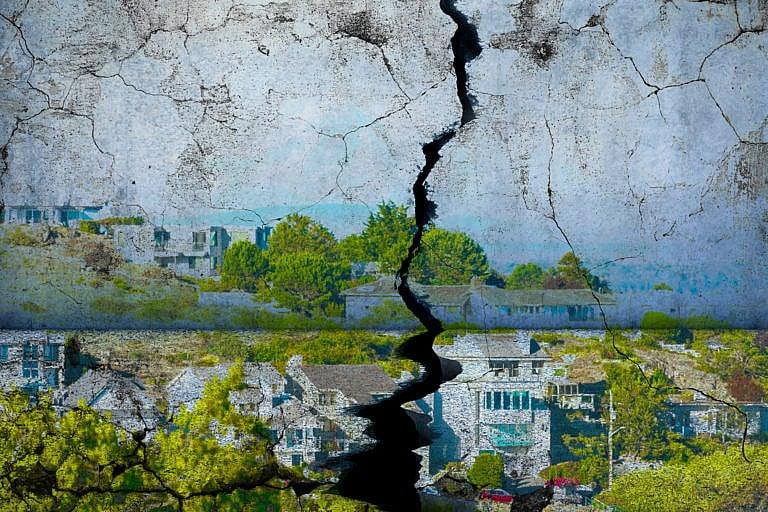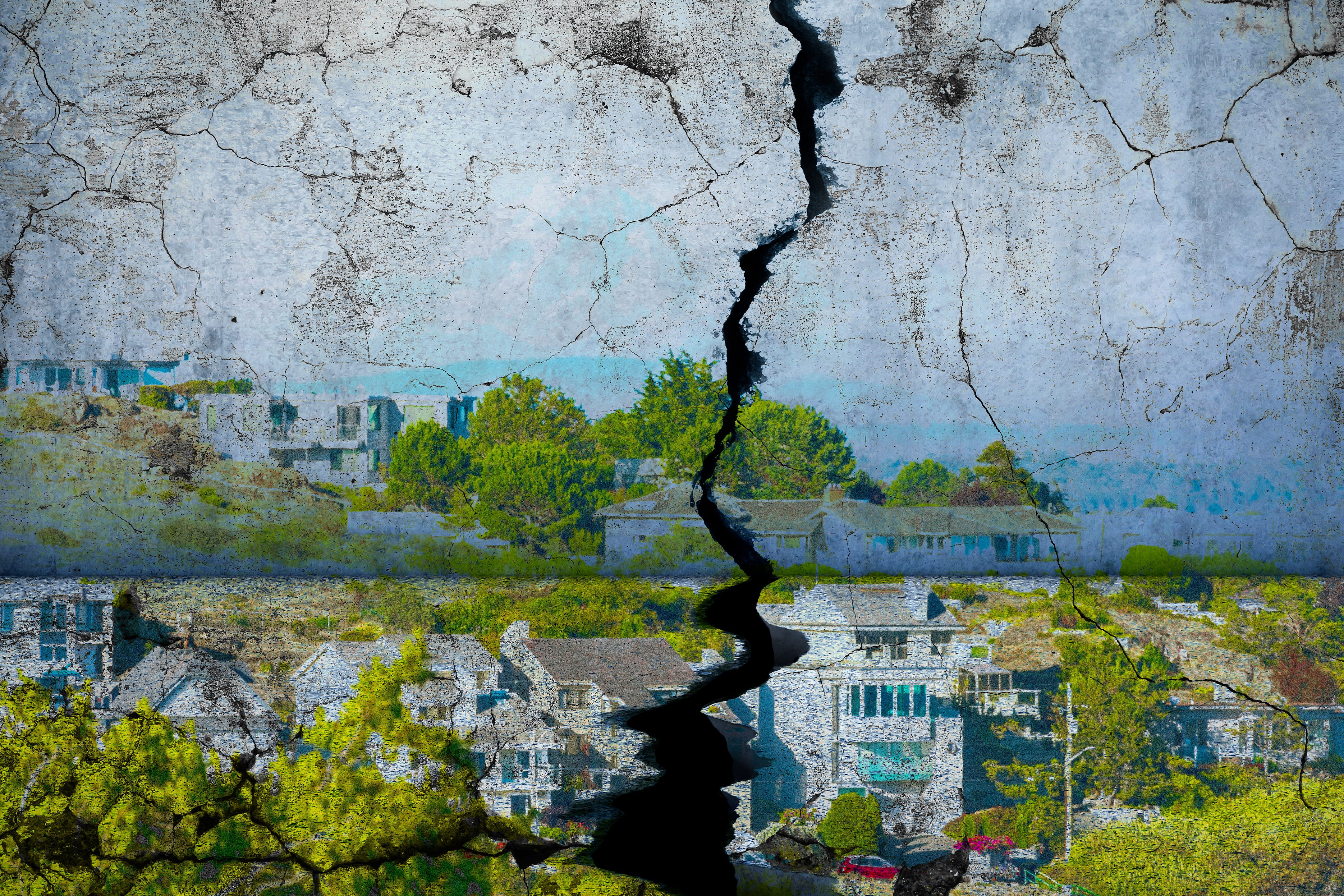I’ve spent six years earthquake-proofing my house in anticipation of B.C.’s Big One
Experts warn of a one-in-three chance of Victoria being shaken by earthquakes in the next 50 years. I’m doing all I can to prepare.

Experts warn that Victoria, BC is due for a massive earthquake in the future, prompting homeowners to plan accordingly. (Illustration by Maclean’s)
Share

For West Coasters, it’s hard to ignore the threat of the Big One—especially in Victoria, the city where I live, and which is probably at greater risk of major devastation due to an earthquake than any other Canadian city. Every time an earth-shaking tragedy happens somewhere else, that risk is brought into sharp relief, because we know one day it will happen here—and “one day” may not be that far into the future.
READ: The Big Burn: How B.C. is learning to live with wildfires
A report commissioned by the city of Victoria in 2017 looked at different types of earthquakes that could shake the city, including two worst-case scenarios: an offshore, magnitude-9 subduction quake, or a magnitude-7 crustal quake, closer to the city. The first would be caused by the massive undersea fault stretching all the way from northern California to the north tip of Vancouver Island. Scientists know that it produces massive quakes every few hundred years. There are records in Indigenous oral history of a huge earthquake around the year 1700, as well as written records from Japan of an “orphan tsunami” that year, which suggest Cascadia last ripped open 323 years ago. Scientists estimate the Cascadia subduction zone produces a quake every 200 to 800 years, so we’re within the window, with an estimated 10 per cent chance during the next 50 years. Add to that the risk of other tremors, including a crustal quake, and there may be a one-in-three chance of the city being violently shaken in the next 50 years.
RELATED: An Edmonton couple refitted their home to be completely net zero
The city’s report painted a bleak picture of what would happen: hundreds of buildings could collapse, and thousands more would be damaged beyond repair. The study estimated the city could lose nearly two-thirds of its entire building stock in either kind of quake—a civic disaster unmatched in modern Canadian history.
I’ve long assumed that the odds of my old house being one of the survivors of a quake like this are slim. The 111-year-old wood frame house is long on charm but short on modern seismic innovations. So in 2018, I hired a seismic engineer. Graham Taylor is an expert in the field, who’s worked on British Columbia’s school seismic renovation efforts. (His predictions are as bleak as the province’s—he’s estimated up to 2,000 people in the Victoria area could be killed in a big quake.) Taylor inspected my walls, the basement, the ground beneath my house and a few other important factors, and confirmed my suspicions: my house wasn’t likely to make it. After a few minutes of side-to-side shaking, the nails in the old boards on my basement walls will probably work themselves loose, at which point the boards will fall off the vertical two-by-four wall studs that support the house on top of the concrete foundation. Once those boards fly off, it will only take a bit more shaking before the wall studs succumb to the horizontal motion and topple over sideways, bringing the top two floors crashing down on the basement. Anyone in the top two floors would probably not be crushed, but the house would be destroyed.

On hearing that kind of news, Taylor says, some homeowners simply decide to leave. He’s seen some people move thousands of kilometres away—both because the thought of the earthquake terrified them, and due to the unsettling questions about what life would be like after the event, when food and shelter could be in extremely short supply. But I’ve got a job and a life here, so I decided I would make my house stronger.
READ: Why I’m suing the Ontario government over its climate change inaction
I had, in fact, already done a fair bit of work the year before I hired Taylor. I’d nailed steel reinforcement plates to the junctions between the vertical support posts and the horizontal ceiling beams in my basement—the beams simply rest on the posts, which has been fine during the past century, because the ground hasn’t moved, and the weight of an entire house on top keeps things firmly in place. In a big quake, though, basement posts often shake loose from the beams they’re supporting. I also bolted the hot water tank to the wall, so we wouldn’t have a flooded basement—and we have a big container full of clean water, even if all the water lines ruptured. I even screwed my bookshelves to the walls with steel L-brackets to make sure no one in my family got knocked out by our home library.
But the basement walls were key to keeping the house standing. I could hire a contractor to do the work—but Taylor suggested I could do the work myself to save money. It’s expensive, time-consuming and laborious, but it’s pretty straightforward, too. Since my mortgage doesn’t pay itself and our grocery bill gets bigger monthly, I took a deep breath and got to work, beginning on the outside.
The house was covered in old cedar shakes that needed replacing anyway, so I pried them off, then proceeded to pry off the old boards underneath, nailed sideways onto the vertical studs. I found a lot of spiders, mouse droppings and dust along the way, but following the relatively straightforward plans, I methodically nailed new, three-quarter inch plywood to the wall studs, where the old boards had been. The new plywood is far stronger, and the plans call for a lot more nails, in a specific nailing pattern. I also cut the plywood in half before nailing it to the wall, so it has a built-in break to absorb some of the side-to-side motion when the shaking starts.

A lot of seismic retrofits like this also call for steel bolts, to attach the wood frame of the house to concrete foundations, but Taylor told me it wasn’t necessary, and would probably just give me a leaky basement because of potential holes and cracks in the old concrete.
All of these engineering fixes are based on real-world observations of how wooden houses have responded to real earthquakes, in California and elsewhere. They’re also based on earthquake simulations, like those performed on the giant “shake table” earthquake simulator at the University of British Columbia. I visited the simulator once, with Taylor, and watched it shake a large plywood room, the size of a school classroom. It had giant steel plates resting on top of it, and the engineers had programmed the table to replicate the exact shaking pattern from the deadly 2011 Tohoku earthquake in Japan. When the plywood classroom shook for more than two minutes, the nails holding the plywood to the wall studs hardly moved. But similar simulations with walls like my basement—with narrower boards and fewer nails—showed the nails popping out under sustained shaking, eventually collapsing the walls.
That was a vivid reminder of what is not only possible, but eventually, guaranteed to hit my house—unless I finish the work in time. But after countless weekend hours of prying, measuring, cutting, and hammering away, I’m still only a quarter done. Life keeps getting in the way. First came the pandemic. Then the price of lumber tripled. There’s my regular job, my side gig writing a second book—my first one, about Canada’s under-recognized earthquake risk, was published in 2021—and family life. Taking a glance at the calendar on the fridge as I write this, I see all three kids are playing in a water polo tournament this weekend. So all in all, I’m about two years behind schedule. Realistically, I hope to finish the basement walls in the fall of 2024.
MORE: How 16-year-old Naila Moloo is making waves as an environmental innovator
And even then, the seismic retrofit won’t be done. After that I’ll have to figure out what to do with the two old chimneys, one on either side of the house, that could become a hail of deadly bricks in a big quake. It’s happened before that people run out of buildings which end up remaining standing, only to be killed by raining bricks. There’s a solid argument for getting rid of most, if not all, brick chimneys in a seismic zone, but mine still tower above my old house. Most of the other houses in my neighbourhood have similar chimneys, and one day, some of them will surely come tumbling down.
I’m not happy to be behind schedule, but I’m trying to go easy on myself. After all, there are a lot of other things to worry about in life, and money and time are hard to come by. Maybe that’s why so many thousands of buildings in Victoria, Vancouver and beyond are still as vulnerable as my house—including plenty of publicly owned buildings. Half of British Columbia’s vulnerable public schools, for example, have been given seismic retrofits, at a cost of more than $2 billion—but that also means half have not.
And while the chances of a catastrophic earthquake in our lifetime are highest on the West Coast, this isn’t the only part of the country at risk. Ottawa, Montreal and Quebec City all lie in seismic zones that have produced major events in the past. They’re full of older, unreinforced masonry and wood-framed buildings, and newer buildings are no better off, since they’re not constructed in those areas with seismic risk in mind. The east coast isn’t entirely safe either; the ocean floor off Newfoundland could rumble once again like it did in 1929, when it triggered the deadly Burin Peninsula tsunami, which devastated fishing villages in that province, and claimed 28 lives. The truth is that the clock keeps ticking for many Canadian communities—and millions of us who live in active seismic zones had better hope we still have enough time to get ready.